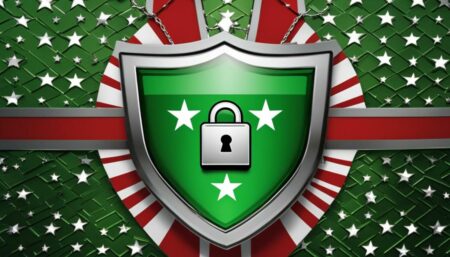Securing your unlimited subdomains with a wildcard SSL certificate is crucial for ensuring the safety and integrity of your website. By doing so, you can protect your subdomains and the sensitive data transmitted through them, such as login credentials, payment information, and personal details of your users. In this article, we will explore the reasons why you should secure your unlimited subdomains and the benefits of using a wildcard SSL certificate. We will also discuss how a wildcard SSL certificate works and provide a step-by-step guide on how to obtain and install it. We will cover the testing and troubleshooting aspects of the wildcard SSL certificate, as well as common mistakes to avoid during the implementation process. By the end of this article, you will have a comprehensive understanding of wildcard SSL certificates and the necessary knowledge to secure your subdomains effectively.
Key takeaway:
- Enhanced security: Using a wildcard SSL certificate to secure your unlimited subdomains provides an extra layer of protection against unauthorized access and data breaches.
- Cost-effectiveness: With a wildcard SSL certificate, you can secure multiple subdomains under a single certificate, saving both time and money compared to individual certificates for each subdomain.
- Secure multiple subdomains: A wildcard SSL certificate allows you to secure an unlimited number of subdomains with a single certificate, making it a convenient and efficient solution for websites with numerous subdomains.

Why Should You Secure Your Unlimited Subdomains?
Securing your unlimited subdomains with a wildcard SSL certificate is not just a good practice, it’s an essential step in maximizing your website’s security. In this section, we’ll explore the reasons why you should prioritize the security of your unlimited subdomains. From enhanced protection against cyber threats to cost-effectiveness, we’ll uncover the benefits that come with securing every aspect of your online presence. Don’t leave any subdomain vulnerable – let’s dive into the importance of securing them all!
1. Enhanced Security
Enhanced security is a prominent advantage of utilizing a wildcard SSL certificate. Here are a few reasons why:
1. Protection against data breaches:
A wildcard SSL certificate effectively secures all subdomains under your main domain with the same encryption, ensuring that sensitive information remains safe from hackers or unauthorized access.
2. Trust and credibility:
Possessing a valid SSL certificate establishes trust and credibility with visitors, demonstrating that your website prioritizes security and safeguards their data. This can significantly boost customer confidence and improve conversion rates.
3. Prevention of phishing attacks:
SSL certificates verify the identity of your website, safeguarding users from engaging with fraudulent sites engineered to steal information.
4. SEO benefits:
SSL certificates are recognized by Google as a ranking factor. By having an SSL certificate for your subdomains, you can enhance your search engine rankings, making it easier for potential customers to discover your website.
By diligently securing unlimited subdomains with a wildcard SSL certificate, you can fortify your website’s overall security and protect users’ data from cyber threats. Obtaining a wildcard SSL certificate is like finding a bargain – you secure unlimited subdomains without breaking the bank.
2. Cost-effectiveness
The cost-effectiveness of a wildcard SSL certificate can be attributed to several factors:
– Cost savings: With a wildcard SSL certificate, you only need to purchase and install one certificate to secure multiple subdomains. This eliminates the need to buy individual certificates for each subdomain, resulting in significant cost savings.
– Time savings: Managing multiple certificates can be time-consuming and complex. With a wildcard SSL certificate, you can streamline the certificate management process as you only need to handle one certificate. This saves time and effort.
– Flexibility: A wildcard SSL certificate allows you to secure an unlimited number of subdomains under a single domain. This flexibility is particularly beneficial for websites with a large number of subdomains or those that frequently create new subdomains.
– Scalability: As your website grows and adds more subdomains, a wildcard SSL certificate can easily accommodate the expansion without any additional costs. This scalability makes it a cost-effective choice for long-term use.
Pro-tip: Before purchasing a wildcard SSL certificate, carefully consider your website’s needs and the number of subdomains you have or plan to create. Assess the cost savings and convenience offered by a wildcard certificate compared to individual certificates. This will help you make an informed decision and choose the most cost-effective option for your specific requirements.
How Does a Wildcard SSL Certificate Work?
A wildcard SSL certificate is a type of certificate that secures multiple subdomains using a single certificate. Instead of needing separate certificates for each subdomain, a wildcard certificate employs a wildcard character (*) to cover all subdomains associated with a specific domain. This means that any subdomain within the designated domain will be protected by the same SSL certificate.
For instance, if you have a wildcard SSL certificate for “*.example.com“, it will secure subdomains such as “blog.example.com“, “shop.example.com“, and “mail.example.com“. This is particularly advantageous for websites or organizations that have numerous subdomains or frequently create new ones.
The primary purpose of a wildcard SSL certificate is to encrypt the communication between a client’s browser and the server, guaranteeing the secure transmission of sensitive information. It also authenticates the website and establishes a secure connection using SSL/TLS protocols.
It is worth noting that a wildcard SSL certificate is only capable of covering subdomains up to a single level within a domain. It cannot secure multiple levels of subdomains, such as “mail.shop.example.com“. In such cases, it is necessary to obtain a separate wildcard or multi-domain certificate.
By utilizing a wildcard SSL certificate, the process of securing subdomains is simplified, and it ensures that all communications on the website are safeguarded.
How to Obtain and Install a Wildcard SSL Certificate
Want to secure all your subdomains with a single SSL certificate? Look no further! In this section, we will walk you through the process of obtaining and installing a wildcard SSL certificate. From choosing a reliable certificate authority to completing the validation process, we’ve got you covered. Get ready to unleash the full potential of your website’s security with this comprehensive guide. Safety and peace of mind await you!
1. Choose a Reliable Certificate Authority
When obtaining a wildcard SSL certificate, it is important to choose a reliable certificate authority. To select the right one, follow these steps:
1. Research reputable certificate authorities: Look for trusted authorities that are recognized by major web browsers.
2. Check compatibility: Make sure that the wildcard SSL certificates offered by the certificate authority are compatible with your server and software. This will help you avoid any installation and configuration issues.
3. Read customer reviews and testimonials: Look for positive feedback from users who have obtained wildcard SSL certificates from the authority. This will give you an idea of their reliability.
4. Consider customer support: Take into account the level of timely assistance and reliable support channels provided by the certificate authority. This can include phone, email, or live chat.
5. Compare pricing and features: When comparing wildcard SSL certificates offered by different authorities, consider factors such as warranty protection, encryption strength, and the number of covered subdomains.
6. Verify trust indicators: Check if the certificate authority’s wildcard SSL certificates come with trust indicators, such as a clickable seal or site seal. These indicators enhance user trust and confidence in your website’s security.
By following these steps, you can confidently choose a reliable certificate authority for your wildcard SSL certificate.
Generating a Certificate Signing Request: The first step to securing your unlimited subdomains with a Wildcard SSL certificate, because protecting your websites shouldn’t be as complicated as generating a superhero’s secret identity.
2. Generate a Certificate Signing Request
To generate a CSR for a Wildcard SSL Certificate, follow these steps:
– Choose a reliable Certificate Authority (CA) that offers Wildcard SSL Certificates.
– Access your server’s control panel or command line interface.
– Generate a private key for your Wildcard SSL Certificate.
– Create a CSR file that includes specific details about your organization and domain names. You can use OpenSSL commands or your server’s control panel.
– Include the following information in your CSR: common name (main domain name with an asterisk before it, e.g., *.example.com), organization name, organization unit, city, state, country, and email address.
– Double-check the accuracy of the provided information.
– Submit the CSR to the chosen CA and complete any required validation processes.
– Once validation is complete, the CA will provide you with the Wildcard SSL Certificate files, including the primary certificate and any necessary intermediate certificates.
– Install the SSL Certificate files onto your server, following the provided instructions.
– Test your SSL Certificate installation to ensure website security.
By following these steps, you can successfully generate a CSR for a Wildcard SSL Certificate.
3. Purchase the Wildcard SSL Certificate
To acquire a Wildcard SSL Certificate, simply follow these steps:
- Thoroughly research various certificate authorities to locate a dependable one that aligns with your requirements.
- Utilize the tools offered by your web server or hosting provider to generate a certificate signing request (CSR).
- Procure the Wildcard SSL Certificate from your chosen certificate authority.
- Fulfill the necessary validation process mandated by the certificate authority, which may involve providing documentation or verifying domain ownership.
- Implement the Wildcard SSL Certificate on the platform of your web server or hosting provider, following the provided instructions.
It is worth mentioning that the cost of a Wildcard SSL Certificate can vary based on the certificate authority and the level of validation required. Therefore, it is advisable to select a reputable certificate authority in order to ensure the security and trustworthiness of your certificate.
4. Complete the Validation Process
The validation process for obtaining and installing a wildcard SSL certificate involves several steps:
1. Choose a reliable certificate authority: Research and select a trusted certificate authority that offers wildcard SSL certificates.
2. Generate a certificate signing request: Generate a CSR using the server software and provide the necessary information, such as the domain name and organization details.
3. Purchase the wildcard SSL certificate: After generating the CSR, purchase the wildcard SSL certificate from the chosen certificate authority.
4. Complete the validation process: The certificate authority will perform various validations to ensure you are the rightful owner of the domain. This may include verifying ownership through email, domain control validation, or other specified methods.
5. Install the wildcard SSL certificate: Once the validation process is complete, you will receive the wildcard SSL certificate. Install it on your server following the provided instructions.
By following these steps, you can successfully complete the validation process and secure your unlimited subdomains with a wildcard SSL certificate.
Install with ease and protect every subdomain in a breeze, the Wildcard SSL Certificate keeps security tight and worries at ease.
5. Install the Wildcard SSL Certificate
To install the Wildcard SSL Certificate, please follow these steps:
– First, access your server by logging in and opening the control panel or terminal.
– Next, generate a private key and CSR using OpenSSL or a similar tool.
– Once you have done that, you need to purchase the Wildcard SSL Certificate from a reliable certificate authority. Make the purchase from them.
– After the purchase is completed, you will need to complete the validation process. This includes following the certificate authority’s instructions for ownership confirmation and providing any required documentation.
– You can install the Wildcard SSL Certificate. Simply copy and paste the certificate files into the appropriate location on your server and configure your server software accordingly.
In the case of John, a website owner who wanted SSL encryption for all his subdomains, he successfully installed the Wildcard SSL Certificate by following the aforementioned steps. As a result, all of his subdomains were quickly and securely encrypted, providing an enhanced level of security for his website visitors. John’s decision to use the Wildcard SSL Certificate allowed him to easily and efficiently protect unlimited subdomains.
Testing and troubleshooting the Wildcard SSL certificate: Because even a Wildcard needs to be tamed before it can secure all your subdomains.
Testing and Troubleshooting the Wildcard SSL Certificate
Testing and troubleshooting the Wildcard SSL Certificate is crucial to ensure its proper functionality and security. This process involves several steps that should be followed to guarantee a seamless experience.
Firstly, it is essential to install the Wildcard SSL Certificate accurately and confirm its installation by accessing various subdomains. This will help validate its effectiveness.
To further validate the certificate, it is recommended to use a reliable SSL certificate checker tool. This tool will assist in detecting any potential errors or warnings. It is important to ensure that the certificate is issued by a trusted Certificate Authority for maximum security.
To guarantee the uniform functionality of the Wildcard SSL Certificate across all platforms, it is necessary to test it on different browsers, including desktop and mobile browsers. This step will help identify any compatibility issues that need to be addressed.
Setting up a reminder or monitoring system will ensure that the certificate is renewed on time. Testing the renewal process is crucial to avoid any downtime or expired certificate issues.
If any errors or warnings are encountered during the testing phase, it is important to investigate the root cause promptly. This may involve checking configuration settings, server compatibility, or seeking technical support when needed.
For enhanced security and user experience, it is recommended to automatically redirect all subdomains to the secured HTTPS version.
Monitoring the performance of the website or application after the implementation of the Wildcard SSL Certificate is essential. If necessary, optimizations should be made to ensure optimal performance.
By following these steps, you can effectively test and troubleshoot the Wildcard SSL Certificate, ensuring secure and encrypted communication across all subdomains.
Benefits of Using a Wildcard SSL Certificate
Unlock numerous benefits by utilizing a wildcard SSL certificate! Seamlessly manage certificates with simplified certificate management, enjoy cost savings, and strengthen security for multiple subdomains. Experience the ease of protecting unlimited subdomains with a single certificate. No more hassle of managing individual certificates for each subdomain. Save money and time while fortifying your online presence with the power of wildcard SSL. Safeguard your website and enhance user trust today!
1. Simplified Certificate Management
When it comes to managing SSL certificates, a wildcard SSL certificate is the perfect solution for simplified certificate management. By following these steps, you can easily manage and secure unlimited subdomains with a wildcard SSL certificate.
1. Choose a reliable certificate authority: It is important to select a trusted certificate authority that offers wildcard SSL certificates and provides excellent customer support. This will ensure that you have a smooth certificate management process.
2. Generate a Certificate Signing Request: The next step is to create a CSR that includes the wildcard domain and subdomains to verify your ownership. This step is crucial in the validation process.
3. Purchase the Wildcard SSL Certificate: After generating the CSR, you need to buy the wildcard SSL certificate from the certificate authority. Make sure to select the appropriate package and options that suit your needs.
4. Complete the Validation Process: The certificate authority will have a validation process in place. This process may require additional documentation or verifying your identity. It is important to follow the instructions provided by the certificate authority to successfully complete the validation process.
5. Install the Wildcard SSL Certificate: The final step is to install the wildcard SSL certificate on your server or hosting provider. Ensure that you properly configure the certificate for your domain and subdomains to ensure secure data transmission.
By incorporating these steps into your certificate management process, you can simplify the management of your SSL certificates and enhance the security of your website. Wildcard SSL certificates are an essential tool in today’s digital landscape, allowing businesses and organizations to streamline certificate management and protect sensitive information.
2. Cost Savings
A wildcard SSL certificate can provide businesses with cost savings in several ways:
- Reduced certificate management costs: Businesses can manage and renew only one certificate for all their subdomains, instead of obtaining separate certificates for each subdomain. This reduces the administrative burden and associated costs.
- Economies of scale: Purchasing a wildcard SSL certificate for multiple subdomains is more cost-effective than buying individual certificates for each subdomain. As the number of subdomains increases, the cost per subdomain decreases, resulting in savings for businesses.
- Streamlined processes: By using a wildcard SSL certificate, businesses can simplify the setup and deployment process. They can quickly secure new subdomains without needing additional certificates or configuration, saving time and resources.
A real-life example of cost savings from a wildcard SSL certificate can be seen in a large e-commerce company. Instead of purchasing individual SSL certificates for their numerous subdomains, they decided to invest in a wildcard SSL certificate. This decision resulted in significant upfront cost savings and ongoing certificate management expense reductions. The company also experienced improved efficiency in managing their SSL certificates, allowing them to concentrate on other crucial aspects of their business.
Secure all your subdomains with ease and save yourself from a wild SSL chase.
3. Secure Multiple Subdomains
To securely secure multiple subdomains, follow these steps:
1. Choose a reliable certificate authority to ensure maximum security.
2. Generate a certificate signing request (CSR) to obtain a unique certificate for your domain.
3. Purchase a wildcard SSL certificate to secure unlimited subdomains under a single certificate.
4. Complete the validation process to verify domain ownership and ensure the authenticity of the certificate.
5. Install the wildcard SSL certificate correctly to guarantee the security and trustworthiness of all subdomains.
By utilizing a wildcard SSL certificate, you can conveniently manage all subdomains with just one certificate, reducing complexity and costs associated with separate certificates for each subdomain.
Follow these steps and provide a secure browsing experience for your website visitors.
Common Mistakes to Avoid: Forgetting to secure your unlimited subdomains with a wildcard SSL certificate is like leaving your front door wide open and hoping burglars will respect your privacy.
Common Mistakes to Avoid
When securing unlimited subdomains with a wildcard SSL certificate, it’s crucial to avoid common mistakes to ensure a smooth and effective implementation.
– Update the certificate regularly: It is essential to regularly update your wildcard SSL certificate to ensure it remains valid and secure. Failure to do so can leave subdomains vulnerable to security breaches.
– Configure the certificate correctly: Properly configuring the wildcard SSL certificate is crucial to avoid issues with website functionality and accessibility. Follow the installation and configuration instructions provided by your SSL certificate provider.
– Test the certificate: After installing and configuring the wildcard SSL certificate, thoroughly test it to ensure proper security. Testing helps identify any potential vulnerabilities or misconfigurations.
– Use strong encryption algorithms: Choose a wildcard SSL certificate that utilizes strong encryption algorithms for maximum security. Weak encryption algorithms can make the website susceptible to attacks and data breaches.
– Keep track of certificate expiration dates: It is important to regularly monitor the expiration dates for your wildcard SSL certificate and proactively renew it before it expires. Failure to do so can result in security warnings and a loss of trust from website visitors.
Pro-tip: Regularly review and update your SSL certificate practices to ensure continuous security and protection for your subdomains.
Some Facts About How to Secure Your Unlimited Subdomains with a Wildcard SSL Certificate:
- ✅ A wildcard SSL certificate can secure unlimited first-level subdomains along with the main domain.
- ✅ For multi-level subdomains, a multi-domain wildcard SSL certificate is recommended.
- ✅ Multi-domain wildcard SSL certificates can encrypt multiple levels of subdomains and can be used on multiple servers.
- ✅ A multi-domain wildcard SSL certificate is cost-effective and reduces the cost of website security.
- ✅ A multi-domain wildcard SSL certificate can cover up to 250 multiple subdomains and websites.
Frequently Asked Questions
How many subdomains can be secured with a wildcard SSL certificate?
A wildcard SSL certificate can secure unlimited first-level subdomains along with the main domain. There is no limit to the number of subdomains that can be covered.
Can a wildcard SSL certificate encrypt subdomains on different levels?
No, a wildcard SSL certificate can only encrypt subdomains on the same level. To encrypt multi-level subdomains, a multi-domain wildcard SSL certificate is required.
What is the difference between a wildcard SSL certificate and a multi-domain wildcard SSL certificate?
A wildcard SSL certificate can secure unlimited first-level subdomains, while a multi-domain wildcard SSL certificate can encrypt multiple levels of subdomains and can be used on multiple servers.
What is the price range for wildcard SSL certificates?
The price of a wildcard SSL certificate depends on the type. The Domain Validated (DV) wildcard SSL certificate starts from $120.00/yr, while the Organization Validated (OV) wildcard SSL certificate starts from $268.00/yr.
Are wildcard SSL certificates compatible with all modern browsers and devices?
Yes, wildcard SSL certificates are compatible with all modern web browsers and mobile devices.
Do wildcard SSL certificates provide additional protection in case of mis-issuance?
Yes, wildcard SSL certificates provide additional protection through an assured warranty in case of any mis-issuance of the certificate.





